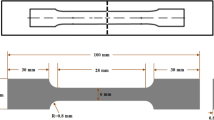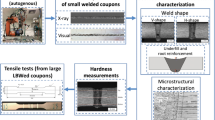Abstract
AA2198 is a relatively new light-weight and high-performance Al-Cu-Li alloy considered for aviation and space applications. However, Al-Cu-Li alloys generally exhibit severe weldability problems for all fusion-welding techniques, such as laser-beam welding. In particular, porosity formation and hot cracking are observed for the laser-beam welding of these alloys. A common remedy for hot cracking is the use of an appropriate filler wire with a high Si content. In the present study, three different approaches for improving the hot cracking susceptibility of AA2198 laser beam welded without any filler material are presented. For this purpose, pre-heating of the weld samples to elevated temperatures, pre-loading of the weld samples perpendicular to the welding direction, or an optimization of the laser-beam welding parameters were conducted. The autogenously welded samples were assessed with regard to the resulting total crack length and their mechanical properties. It was demonstrated that all of the presented approaches led to a reduction of hot cracking. However, the largest effect was observed for the use of low levels of laser power and welding velocity. The mechanical properties of the optimised autogenously welded samples are only marginally inferior as for the samples laser welded with the Al-Si filler wire AA4047.
Similar content being viewed by others
References
Kostrivas A, Lippold JC (1999) Weldability of Li-bearing aluminium alloys. Int Mater Rev 44:217–237. https://doi.org/10.1179/095066099101528289
Srivatsan TS, Sudarshan TS (1991) Welding of lightweight aluminium-lithium alloys. Weld J 70:173–184
Giummarra C, Thomas B, Rioja RJ (2007) New aluminum lithium alloys for aerospace applications. In: Proc Light Met Technol Conf 2007
Lippold JC, Lin W (1996) Weldability of commercial Al-Cu-Li alloys. Mater Sci Forum 217:1685–1690. https://doi.org/10.4028/www.scientific.net/MSF.217-222.1685
Allen CM, Verhaeghe G, Hilton PA, Heason CP, Prangnell PB (2006) Laser and hybrid laser-MIG welding of 6.35 and 12.7 mm thick aluminium aerospace alloy. Mater Sci Forum 519:1139–1144. https://doi.org/10.4028/www.scientific.net/MSF.519-521.1139
Ellis MBD (1996) Fusion welding of aluminium-lithium alloys. Weld Metal Fabr 64:55–60
Ion JC (2000) Laser beam welding of wrought aluminium alloys. Sci Techol Weld Join 5:265–276. https://doi.org/10.1179/136217100101538308
Cross CE (2005) On the origin of weld solidification cracking. In: Böllinghaus T, Herold H (eds) Hot cracking phenomena in welds I. Springer-Verlag, Berlin, pp 3–18. https://doi.org/10.1007/3-540-27460-X_1
Kostrivas A, Lippold JC (1999) Weldability of Li-bearing aluminium alloys. Int Mat Rev 44(6):217–237. https://doi.org/10.1179/095066099101528289
Katgerman L, Eskin DG (2005) In search of the prediction of hot cracking in aluminium alloys. In: Böllinghaus T, Herold H (eds) Hot cracking phenomena in welds II. Springer-Verlag, Berlin, pp 11–26. https://doi.org/10.1007/978-3-540-78628-3_1
Dittrich D, Standfuss J, Liebscher J, Brenner B, Beyer E (2011) Laser beam welding of hard to weld Al alloys for regional aircraft fuselage design—first results. Phys Proc 12:113–122. https://doi.org/10.1016/j.phpro.2011.03.015
Tian Y, Robson JD, Riekehr S, Kashaev N, Wang L, Lowe T, Karanika A (2016) Process optimization of dual-laser beam welding of advanced Al-Li alloys through hot cracking susceptibility modelling. Metall Mater Trans A 47:3533–3544. https://doi.org/10.1007/s11661-016-3509-4
Rappaz M, Drezet JM, Gremaud M (1999) A new hot-tearing criterion. Metall Mater Trans A 30:449–456. https://doi.org/10.1007/s11661-999-0334-z
Mousavi MG, Cross CE, Grong Ø (1999) Effect of scandium and titanium-boron on grain refinement and hot cracking of aluminium alloy 7108. Sci Technol Weld Join 4:381–388. https://doi.org/10.1179/136217199101538030
Huang H, Fu PH, Wang YX, Peng LM, Jiang HY (2014) Effect of pouring and mold temperatures on hot tearing susceptibility of AZ91D and Mg–3Nd–0.2 Zn–Zr Mg alloys. Trans Nonferrous Metals Soc China 24:922–929. https://doi.org/10.1016/S1003-6326(14)63144-7
Zhu C, Tang X, He Y, Lu F, Cui H (2018) Effect of preheating on the defects and microstructure in NG-GMA welding of 5083 Al-alloy. J Mat Process Technol 251:214–224. https://doi.org/10.1016/j.jmatprotec.2017.08.037
Wang CS, Starink MJ, Gao N (2006) Precipitation hardening in Al-Cu-Mg alloys revisited. Scr Mater 54:287–291. https://doi.org/10.1016/j.scriptamat.2005.09.010
Coniglio N (2008) Aluminium alloy weldability: identification of weld solidification cracking mechanisms through novel experimental technique and model development. Doctoral thesis; Otto von Guericke University Magdeburg
Beyer E (1995) Schweißen mit Laser: Grundlagen. Springer-Verlag, Berlin. https://doi.org/10.1007/978-3-642-75759-4
Enz J, Riekehr S, Ventzke V, Huber N, Kashaev N (2016) Laser weldability of high-strength Al-Zn alloys and its improvement by the use of an appropriate filler material. Metall Trans A 47:2830–2741. https://doi.org/10.1007/s11661-016-3446-2
Alexopoulos ND, Proiou A, Examilioti T, Kashaev N, Riekehr S, Kourkroulis SK (2016) Effect of artificial aging on the mechanical performance of (Al-Cu) 2024 and (Al-Cu-Li) 2198 aluminum alloys. Proc Struct Integr 2:3782–3783. https://doi.org/10.1016/j.prostr.2016.06.470
Wang X, Lu F, Wang HP, Qu Z, Xia L (2016) Micro-scale model based study of solidification cracking formation mechanism in Al fiber laser welds. Mat Process Technol 231:18–26. https://doi.org/10.1016/j.jmatprotec.2015.12.006
Ning J, Zhang LJ, Bai QL, Yin XQ, Niu J, Zhang JX (2016) Comparison of the microstructure and mechanical performance of 2A97 Al-Li alloy joints between autogenous and non-autogenous laser welding. Mat and Des 120:144–156. https://doi.org/10.1016/j.matdes.2017.02.003
Enz J, Riekehr S, Ventzke V, Huber N, Kashaev N (2016) Fibre laser welding of high-alloyed Al-Zn-Mg-Cu alloys. J Mat Process Technol 237:155–162. https://doi.org/10.1016/j.jmatprotec.2016.06.002
Author information
Authors and Affiliations
Corresponding author
Rights and permissions
About this article
Cite this article
Enz, J., Carrarin, C., Riekehr, S. et al. Hot cracking behaviour of an autogenously laser welded Al-Cu-Li alloy. Int J Adv Manuf Technol 95, 299–310 (2018). https://doi.org/10.1007/s00170-017-1197-x
Received:
Accepted:
Published:
Issue Date:
DOI: https://doi.org/10.1007/s00170-017-1197-x




